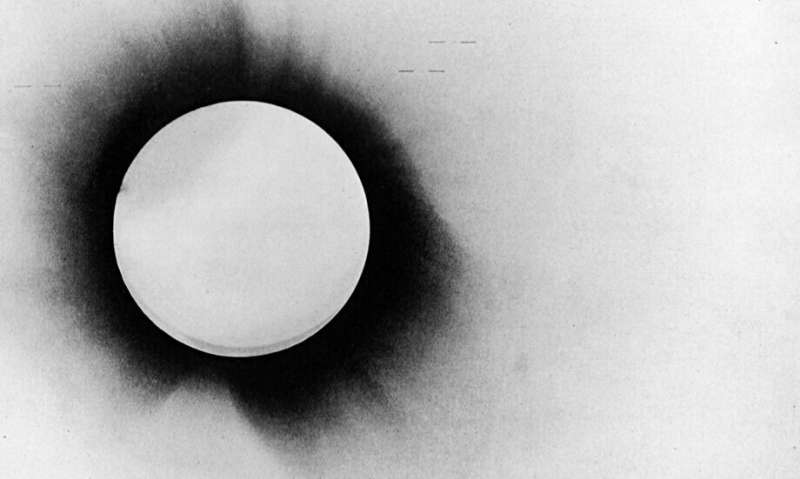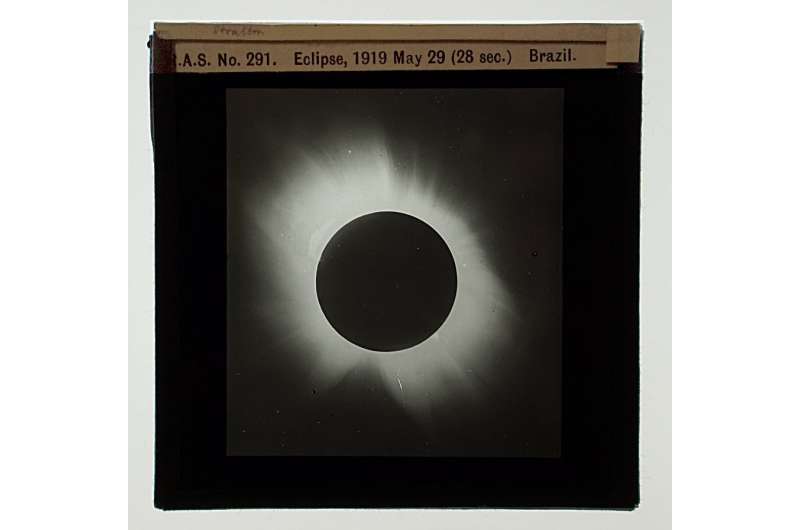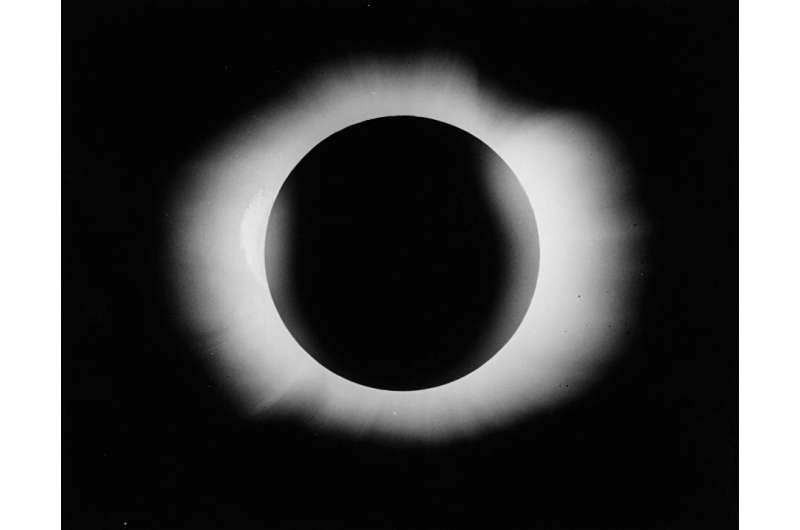A half-tone reproduction of one of the negatives taken with the 4-inch lens at Sobral, where the stars measured are between each set of dash marks. Published in F.W. Dyson, A.S. Eddington, C. Davidson, ‘A determination of the deflection of light by the Sun’s gravitational field, from observations made at the Total Eclipse of May 29, 1919’, Memoirs of the Royal Astronomical Society, vol. 62 (1923). Credit: Royal Astronomical Society
Celebrations are underway across the globe to commemorate 100 years since a UK-led expedition confirmed Einstein's general theory of relativity. The theory fundamentally changed our understanding of physics and astronomy, and underpins critical modern technologies such as the satellite-based Global Positioning System (GPS). A series of public events in the UK and around the world will mark this seminal anniversary.
The theory of relativity is essential for the correct operation of GPS systems, which in turn are relied on in many common applications including vehicle satellite navigation (SatNav) systems, weather forecasting, and disaster relief and emergency services. However the world had to wait decades before the applications of such a blue skies result could be realised.
On 29 May 1919, astronomer Sir Arthur Eddington verified Einstein's general theory of relativity by observing the apparent deflection of stars from their normal positions during a solar eclipse. This happens because, according to Einstein's theory, the path of light is bent by gravity when it travels close to a massive object like our Sun.
This effect is measurable during a solar eclipse, when the Sun's light is blocked by the Moon. At such times, the light from the background stars closest to the edge of the Sun is bent, and so these stars appear to be in slightly different positions compared to when they are observed at other times.
The result was based on measurements taken by two UK-led expeditions, one to the island of Principe off the west coast of Africa, and the other to Sobral in Brazil. Two sites were chosen to increase the chances of success, and to ensure good conditions for viewing the eclipse.
Photograph of the lantern slide showing the eclipse of the Sun, Sobral, 29 May 1919, 28 seconds. Reference: RAS No. 291. Credit: Royal Astronomical Society
The expeditions were jointly funded by the Royal Astronomical Society (RAS), the Royal Society, and the Royal Irish Academy, and organised by the Royal Observatory Greenwich. When the results were announced at a joint meeting of the RAS and Royal Society in November of the same year, it made Einstein world famous within days.
In the UK this bank holiday weekend, the Observatory Science Centre in Herstmonceux, Sussex, will be celebrating with a week of family friendly activities and talks from 25 May to 2 June, including a live video-link with Principe, one of the eclipse expedition sites.
At Burlington House in London, on 29 and 31 May, the Royal Astronomical Society will host solar observing events (weather permitting), and the library will display historical images and documents related to the 1919 eclipse. Visitors will also encounter actors playing the roles of Arthur Eddington and Albert Einstein.
Other celebratory activities will be taking place in the UK, Portugal, Principe, Sobral and around the world: more information on all of the events can be found on the Eclipse 1919 events page [ eclipse1919.org/index.php/events ].
Positive copy of the photograph of the solar eclipse by Arthur Eddington and Edwin Cottingham, Principe, 29 May 1919, 2h 17m 33s. Reference: A7/40. Credit: Royal Astronomical Society
Prof. Mike Cruise, President of the Royal Astronomical Society, said, "A century ago astronomers confirmed the general theory of relativity—in the process transforming our understanding of the universe forever. The work of Einstein and Eddington is an amazing example of international collaboration in the aftermath of the first world war, and a visible demonstration of how science can overcome barriers in these turbulent times."
In November the RAS and Royal Society will host a conference and public event marking the 100th anniversary of the announcement of the results. The commemoration forms part of the centenary of the International Astronomical Union, founded in 1919, with more than 200 schools around the world signed up to explore the role of gravity in astronomy.
More information: More information on the expeditions, science, and global events can be found on the Eclipse 1919 website at eclipse1919.org/
Provided by Royal Astronomical Society

























